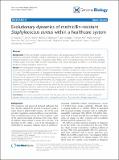Files in this item
Evolutionary dynamics of methicillin-resistant Staphylococcus aureus within a healthcare system
Item metadata
| dc.contributor.author | Hsu, Li-Yang | |
| dc.contributor.author | Harris, Simon R | |
| dc.contributor.author | Chlebowicz, Monika A | |
| dc.contributor.author | Lindsay, Jodi A | |
| dc.contributor.author | Koh, Tse-Hsien | |
| dc.contributor.author | Krishnan, Prabha | |
| dc.contributor.author | Tan, Thean-Yen | |
| dc.contributor.author | Hon, Pei-Yun | |
| dc.contributor.author | Grubb, Warren B | |
| dc.contributor.author | Bentley, Stephen D | |
| dc.contributor.author | Parkhill, Julian | |
| dc.contributor.author | Peacock, Sharon J | |
| dc.contributor.author | Holden, Matthew T G | |
| dc.date.accessioned | 2015-04-28T12:01:02Z | |
| dc.date.available | 2015-04-28T12:01:02Z | |
| dc.date.issued | 2015-04-23 | |
| dc.identifier | 183840848 | |
| dc.identifier | 148f0f53-3b9a-41bc-8248-435da2a17862 | |
| dc.identifier | 25903077 | |
| dc.identifier | 84939156743 | |
| dc.identifier | 000353374900001 | |
| dc.identifier.citation | Hsu , L-Y , Harris , S R , Chlebowicz , M A , Lindsay , J A , Koh , T-H , Krishnan , P , Tan , T-Y , Hon , P-Y , Grubb , W B , Bentley , S D , Parkhill , J , Peacock , S J & Holden , M T G 2015 , ' Evolutionary dynamics of methicillin-resistant Staphylococcus aureus within a healthcare system ' , Genome Biology , vol. 16 , 81 . https://doi.org/10.1186/s13059-015-0643-z | en |
| dc.identifier.issn | 1474-760X | |
| dc.identifier.other | ORCID: /0000-0002-4958-2166/work/60196440 | |
| dc.identifier.uri | https://hdl.handle.net/10023/6585 | |
| dc.description | SRH, SDB JP and MTGH were supported by Wellcome Trust grant 098051. LYH was funded by the National Medical Research Council Singapore. SP is funded by the UKCRC Translational Infection Research Initiative, and the NIHR Cambridge Biomedical Research Centre. | en |
| dc.description.abstract | Background In the past decade, several countries have seen gradual replacement of endemic multi-resistant healthcare-associated methicillin-resistant Staphylococcus aureus (MRSA) with clones that are more susceptible to antibiotic treatment. One example is Singapore, where MRSA ST239, the dominant clone since molecular profiling of MRSA began in the mid-1980s, has been replaced by ST22 isolates belonging to EMRSA-15, a recently emerged pandemic lineage originating from Europe. Results We investigated the population structure of MRSA in Singaporean hospitals spanning three decades, using whole genome sequencing. Applying Bayesian phylogenetic methods we report that prior to the introduction of ST22, the ST239 MRSA population in Singapore originated from multiple introductions from the surrounding region; it was frequently transferred within the healthcare system resulting in a heterogeneous hospital population. Following the introduction of ST22 around the beginning of the millennium, this clone spread rapidly through Singaporean hospitals, supplanting the endemic ST239 population. Coalescent analysis revealed that although the genetic diversity of ST239 initially decreased as ST22 became more dominant, from 2007 onwards the genetic diversity of ST239 began to increase once more, which was not associated with the emergence of a sub-clone of ST239. Comparative genomic analysis of the accessory genome of the extant ST239 population identified that the Arginine Catabolic Mobile Element arose multiple times, thereby introducing genes associated with enhanced skin colonization into this population. Conclusions Our results clearly demonstrate that, alongside clinical practice and antibiotic usage, competition between clones also has an important role in driving the evolution of nosocomial pathogen populations. | |
| dc.format.extent | 13 | |
| dc.format.extent | 1144212 | |
| dc.language.iso | eng | |
| dc.relation.ispartof | Genome Biology | en |
| dc.subject | RA0421 Public health. Hygiene. Preventive Medicine | en |
| dc.subject | QR355 Virology | en |
| dc.subject | DAS | en |
| dc.subject | BDC | en |
| dc.subject | SDG 3 - Good Health and Well-being | en |
| dc.subject.lcc | RA0421 | en |
| dc.subject.lcc | QR355 | en |
| dc.title | Evolutionary dynamics of methicillin-resistant Staphylococcus aureus within a healthcare system | en |
| dc.type | Journal article | en |
| dc.contributor.institution | University of St Andrews. Biomedical Sciences Research Complex | en |
| dc.contributor.institution | University of St Andrews. Infection Group | en |
| dc.contributor.institution | University of St Andrews. School of Medicine | en |
| dc.identifier.doi | 10.1186/s13059-015-0643-z | |
| dc.description.status | Peer reviewed | en |
This item appears in the following Collection(s)
Items in the St Andrews Research Repository are protected by copyright, with all rights reserved, unless otherwise indicated.

